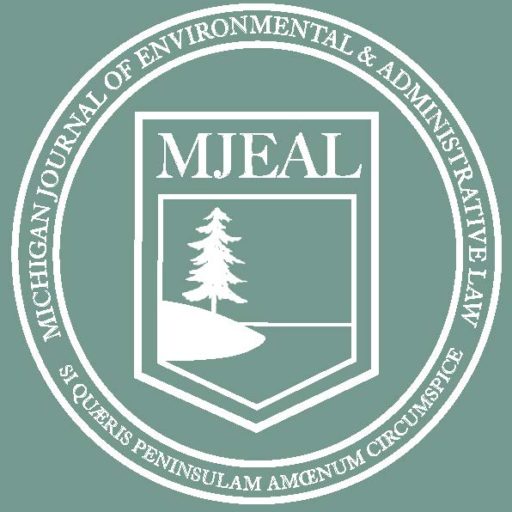A Positive Spin on the End of Chevron?
Ainsley Coty
In late June of 2024, the Supreme Court overturned a decades-long precedent, “Chevron Deference,” in Loper Bright v. Raimondo.1 Chevron Deference required courts to give deference to administrative agencies’ statutory interpretation.2 Now, courts have more power to interpret statutes for themselves, potentially limiting administrative agencies’ ability to regulate. While there is uncertainty regarding how courts will choose to utilize their new-found control, the general sentiment from environmentalists is that “[t]he net effect will be to weaken our government’s ability to meet the real problems the world is throwing at us — big things like COVID and climate change.”3 There is still hope, however small it may be, that courts could step up and be an avenue for environmental progress rather than a setback.
Chevron v. Natural Resources Defense Council was decided in 1984 during the Reagan Administration.4 Under the Clean Air Act, Congress granted the EPA the power to set regulations for “stationary sources” of pollution.5 The EPA, under Reagan, sought to define “stationary sources” as sources that were entirely new.6 The Natural Resources Defense Council, along with other environmentalist groups, challenged the Reagan Administration’s definition of stationary sources.7 They argued that the EPA was responsible for regulating both entirely new sources of pollution as well as additions made to currently operating plants.8 In a “unanimous” decision, with three justices abstaining, the Court ruled that lower courts should defer to agency interpretation of statutes when that interpretation is reasonable.9 More specifically, the Court stated that “[w]ith regard to judicial review of an agency’s construction of the statute which it administers, if Congress has not directly spoken to the precise question at issue, the question for the court is whether the agency’s answer is based on a permissible construction of the statute.”10
40 years later, Loper Bright has overturned Chevron. The Chief Justice, writing for the majority, referred to Chevron, saying, “[r]espect [for agency interpretation]” was just that.11 The views of the Executive Branch could inform the judgment of the Judiciary, but did not supersede it.12 Whatever respect an Executive Branch interpretation was due, a judge “‘certainly would not be bound to adopt the construction given by the head of a department.’”13 The Court has essentially taken the power it had given administrative agencies to make “reasonable” interpretations of statutes and given the power directly back to the judicial branch.14
Between the 1984 Chevron decision and Loper Bright in 2024, 70% of cases that involved questions of agency interpretation were decided in favor of the agency’s interpretation.15 How many of those decisions would have flipped without Chevron’s Deference? If judges choose to overturn agencies’ interpretations, now, will some choose to push agencies, such as the EPA, to go further? As more cases are decided post-Loper Bright, we may see distinct patterns emerge among the various district and circuit courts.
In December of last year, the U.S. Court of Appeals for the Sixth Circuit laid out how it plans to utilize Loper-Bright’s judicial deference.16 In a case evaluating whether an illegal immigrant should be allowed to remain in the United States, the Sixth Circuit considered whether to accept the Board of Immigration’s finding that Moctezuma-Reyes’ removal from his two, young children (who are U.S. citizens) would not “result in exceptional and extremely unusual hardship.”17 The court determined that while exceptional and extremely unusual hardship was the type of language that implied agency discretion, it is not entitled to give agency discretion unless Congress expressly grants the agency power to utilize its discretion.18 Explicitly, the court said “[t]o be sure, broad language like ‘exceptional and extremely unusual hardship’ looks a bit like terms such as ‘appropriate’ and ‘reasonable.’ But the actual statutes that Loper Bright cited as examples of delegations that may call for deference don’t only have broad language. They pair that language with words that expressly empower the agency to exercise judgment.”19
The Sixth Circuit did not reverse the decision of the Board of Immigration to uphold Moctezuma-Reyes’ removal from the United States. However, the court upheld its decision by coming up with its own definition of “exceptional and extremely unusual hardship,” and it was sure to assert that “there are rare circumstances where a court may have to defer to an agency.”20 The court went a step further and critiqued the concurrence’s belief that “Loper Bright gives us no authority to derive the ‘exceptional and extremely unusual hardship’ standard ‘from new cloth.’”21
The Sixth Circuit appears to be overtly asserting its right to overrule any administrative interpretation of a statute for its own, independent interpretation. That the court would make such statements in a case wherein they ultimately sided with the administrative body indicates that it was eager to alert the legal community to how it will rule following Loper Bright. The consequences of the Sixth Circuit’s approach to its new discretionary authority remains to be seen and will continue to unfold over the next few years, or so long as Loper Bright remains good law.
- 603 U.S. 369 (2024). ↩︎
- Yale School of the Environment, In the Wake of the Chevron Decision, https://environment.yale.edu/news/article/wake-chevron-decision. ↩︎
- Matthew Daly, What it Means for the Supreme Court to Throw Out Chevron Decision, Undercutting Federal Regulations, Associated Press (2024), https://apnews.com/article/supreme-court-chevron-regulations-environment-4ae73d5a79cabadff4da8f7e16669929. ↩︎
- 467 U.S. 837 (1984). ↩︎
- Thomas W. Merrill, The Story of Chevron: The Making of an Accidental Landmark, 66 Admin. L. Rev. 253, 258 (2014), https://scholarship.law.columbia.edu/cgi/viewcontent.cgi?article=1461&context=faculty_scholarship. ↩︎
- Id. ↩︎
- Id. ↩︎
- Id. ↩︎
- Chevron, 467 U.S. at 837. ↩︎
- Id. at 842-45. ↩︎
- Loper Bright, 603 U.S. at 370. ↩︎
- Id. ↩︎
- Id. at 386. ↩︎
- Id. ↩︎
- Jeff Turrentine, The Supreme Court Ends Chevron Deference – What Now?, NRDC (2024), https://www.nrdc.org/stories/what-happens-if-supreme-court-ends-chevron-deference. ↩︎
- Moctezuma-Reyes v. Garland, 124 F.4th 416 (6th Cir. 2024). ↩︎
- Id. ↩︎
- Id. at 420. ↩︎
- Id. ↩︎
- Id. at 421. ↩︎
- Id. at 422. ↩︎
